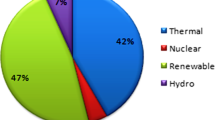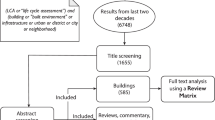Abstract
All over the world, the construction sector is the largest consumer of energy, which has a negative impact on the environment. In this article, the research methodology is adopting building information modeling (BIM) technology in 3D simulation and energy analysis. This study aims using BIM technology to improve indoor daylight performance of the building, determine the proper and comfortable artificial lighting of the building and their costs compared with the traditional methods used to calculate lighting, calculate the amount of renewable energy and cost saving that can be obtained from the photovoltaic panels, assess energy performance analysis at design stage and then create design alternatives to increase energy efficiency. The idea of this research was applied in one of the Iraqi projects; the authors found that applying BIM technology helps a lot in increasing energy performance efficiency through many strategies and it also gives the ability to solve all problems related to the performance of energy in the design stage. The results concluded that applying BIM technology improves indoor daylight performance of the building where the artificial lighting reduce around (29 lamps) as well as the cost of lamps reduce around (6500ID), use photovoltaic(PV) panels reduce annual energy consumption around 44% as well as achieves cost-saving about (22,601 $/year), total electricity consumption equal to (421,645 kw h/year) and total fuel consumption equal to (565,633 MJ/year). Also, the results explain the HVAC system is the most effective alternative where annual energy saving is around (50%).









Similar content being viewed by others
References
Abanda, F. H., & Byers, L. (2016). An investigation of the impact of building orientation on energy consumption in a domestic building using emerging BIM (Building Information Modelling). Energy,97, 517–527. https://doi.org/10.1016/j.energy.2015.12.135.
Abed, H. R., Hatem, W. A., & Jasim, N. A. (2019a). Adopting BIM technology in fall prevention plans. Civil Engineering Journal,5(10), 2270–2281. https://doi.org/10.28991/cej-2019-03091410.
Abed, H. R., Hatem, W. A., & Jasim, N. A. (2019b). Possibility of BIM technology in site safety analysis at Iraqi construction industry. International Journal of Civil Engineering and Technology,10(6), 399–410.
Abed, H. R., Hatem, W. A., & Jasim, N. A. (2020). Role of BIM technology in enhancing safety analysis of Iraqi oil projects. Asian Journal of Civil Engineering,21(4), 695–706. https://doi.org/10.1007/s42107-020-00231-5.
Azhar, S., & Brown, J. (2009). BIM for sustainability analyses. International Journal of Construction Education and Research,5(4), 276–292. https://doi.org/10.1080/15578770903355657.
Azhar, S., Brown, J., & Farooqui, R. (2009). BIM-based sustainability analysis: An evaluation of building performance analysis software. In Proceedings of the 45th ASC annual conference (Vol. 1, No. 4, pp. 276–292).
Bynum, P., Issa, R. R. A., & Olbina, S. (2013). Building information modeling in support of sustainable design and construction. Journal of Construction Engineering and Management,139(1), 24–34. https://doi.org/10.1061/(asce)co.1943-7862.0000560.
Chaichan, M. T. (2016). Gasoline, ethanol and methanol (GEM) ternary blends utilization as an alternative to conventional Iraqi gasoline to suppress emitted sulfur and lead components to environment. Al-Khwarizmi Engineering Journal,12(3), 38–51.
Che, L., Gao, Z., Chen, D., & Nguyen, T. H. (2010). Using building information modeling for measuring the efficiency of building energy performance. In Proceedings of the international conference on computing in civil and building engineering (ICCCBE), Nottingham, UK (pp. 165–170).
Gao, H., Koch, C., & Wu, Y. (2019). Building information modelling based building energy modelling: A review. Applied Energy,238, 320–343. https://doi.org/10.1016/j.apenergy.2019.01.032.
Hatem, W. A., Abd, A. M., & Abbas, N. N. (2018). Barriers of adoption building information modeling (BIM) in construction projects of Iraq. Engineering Journal,22(2), 59–81. https://doi.org/10.4186/ej.2018.22.2.59.
Hatem, W. A., Kwan, A., & Miles, J. (2012). Comparing the effectiveness of face to face and computer mediated collaboration. Advanced Engineering Informatics,26(2), 383–395. https://doi.org/10.1016/j.aei.2012.01.001.
Hickey, R. (2004). Electrical engineer’s portable handbook. New York: McGraw-Hill.
Kaveh, A., & Vazirinia, Y. (2019). Smart-home electrical energy scheduling system using multi-objective ant lion optimizer and evidential reasoning. Scientia Iranica. https://doi.org/10.24200/sci.2019.53783.3412.
Maile, T., Fischer, M., & Bazjanac, V. (2007). Building energy performance simulation tools-a life-cycle and interoperable perspective. In Center for Integrated Facility Engineering (CIFE) Working Paper (Vol. 107, pp. 1–49).
Naji, H. I., Mahmood, M., & Mohammad, H. E. (2019). Using BIM to propose building alternatives towards lower consumption of electric power in Iraq. Asian Journal of Civil Engineering,20(5), 669–679. https://doi.org/10.1007/s42107-019-00134-0.
Najjar, M., Figueiredo, K., Palumbo, M., & Haddad, A. (2017). Integration of BIM and LCA: Evaluating the environmental impacts of building materials at an early stage of designing a typical office building. Journal of Building Engineering,14, 115–126. https://doi.org/10.1016/j.jobe.2017.10.005.
Najjar, M. K., Tam, V. W. Y., Di Gregorio, L. T., Evangelista, A. C. J., Hammad, A. W. A., & Haddad, A. (2019). Integrating parametric analysis with building information modeling to improve energy performance of construction projects. Energies,12(8), 1515. https://doi.org/10.3390/en12081515.
Park, J., Park, J., Kim, J., & Kim, J. (2012). Building information modelling based energy performance assessment system. Construction Innovation,12(3), 335–354. https://doi.org/10.1108/14714171211244587.
Singh, P., & Sadhu, A. (2019). Multicomponent energy assessment of buildings using building information modeling. Sustainable Cities and Society,49, 101603. https://doi.org/10.1016/j.scs.2019.101603.
Author information
Authors and Affiliations
Corresponding author
Ethics declarations
Conflict of interest
There is no conflict of interest.
Additional information
Publisher's Note
Springer Nature remains neutral with regard to jurisdictional claims in published maps and institutional affiliations.
Rights and permissions
About this article
Cite this article
Taha, F.F., Hatem, W.A. & Jasim, N.A. Effectivity of BIM technology in using green energy strategies for construction projects. Asian J Civ Eng 21, 995–1003 (2020). https://doi.org/10.1007/s42107-020-00256-w
Received:
Accepted:
Published:
Issue Date:
DOI: https://doi.org/10.1007/s42107-020-00256-w




